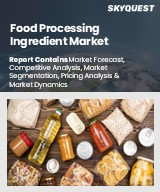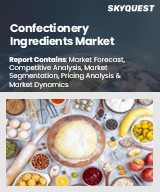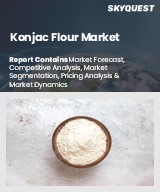
|
시장보고서
상품코드
1822426
세계의 제빵 및 제과 시장 : 예측 - 제품 유형별, 원료별, 카테고리별, 유통 채널별, 최종 사용자별, 지역별 분석(-2032년)Bakery & Confectionery Market Forecasts to 2032 - Global Analysis By Product Type (Bakery Products and Confectionery Products), Ingredient, Category, Distribution Channel, End User and By Geography |
||||||
Stratistics MRC에 따르면 세계의 제빵 및 제과 시장은 2025년에 9,698억 2,000만 달러로 추정되고, 예측 기간 중 CAGR 6.3%로 성장할 전망이며, 2032년에는 1조 4,873억 달러에 이를 전망입니다.
제빵 및 제과 산업이란, 편리하고 맛있고, 호화스러운 식사를 요구하는 소비자 수요에 응하는 구운 과자나 달콤한 과자의 제조 및 판매를 가리킵니다. 제빵 제품에는 빵, 케이크, 패스트리, 쿠키, 비스킷 등이 있으며, 주식과 간식으로 소비되는 경우가 많습니다. 제과는 초콜릿, 사탕, 츄잉껌, 기타 달콤한 기호품 등 설탕을 기반으로 한 다양한 제품을 다룹니다. 이 분야는 전통적인 레시피에 혁신적인 맛, 포장 및 더 건강한 대안을 결합하여 세계 음식 시장에 필수적입니다.
도시화 및 가처분소득 증가
라이프 스타일의 변화와 시간에 제약이 있는 일상생활이, 포장된 구운 과자 및 호화스러운 과자에 대한 기호를 뒷받침하고 있습니다. 소매 및 외식 채널은 제품의 가용성과 버라이어티를 확대하고 있습니다. 제조업체는 프리미엄 포맷, 장인 기술을 구사한 제품, 편리성을 중시한 패키징에 투자하고 있습니다. 조직 소매 및 전자상거래 성장은 소비 동향을 강화하고 있습니다. 이러한 역학은 도시화와 소득 증가를 시장 확대의 주요 촉진요인으로 자리 매김하고 있습니다.
기술 비용 상승
장비 업그레이드, 에너지 효율적인 오븐 및 디지털 모니터링 시스템에는 상당한 선행 투자가 필요합니다. 식품 안전 및 라벨링 규정을 준수하면 작업이 복잡해집니다. 자금 조달과 숙련 노동자에 대한 접근이 제한되어 있기 때문에 채용을 더욱 제한합니다. 비용 압력은 가격에 민감하고 단편화된 시장에서 특히 심각합니다. 이러한 요인은 중소 베이커리 기업의 현대화를 늦추고 있습니다.
지속가능성에 대한 소비자 의식
제조업체 각사는 재활용 가능한 패키징, 식물 유래의 원재료, 탄소 중립적인 생산 방법으로 대응하고 있습니다. 공급망의 인증과 투명성은 브랜드 충성도와 구매 결정에 영향을 미칩니다. 클린 라벨의 처방 및 폐기물 감축에 있어서의 혁신이 지지를 모으고 있습니다. 소매업체와 푸드 서비스 사업자는 지속가능성 목표에 맞는 상품을 제공하도록 되어 있습니다. 이러한 개발은 환경 친화적인 제품 혁신을 위한 좋은 조건을 유지하고 있습니다.
소비자의 건강에 대한 관심 및 취향의 변화
수요는 낮은 탄수화물, 글루텐 프리, 기능적 대체 식품으로 이동하고 있습니다. 영양 표시 및 재제조에 대한 규제 압력은 지역 간에 증가하고 있습니다. 브랜드는 시장과의 관련성을 유지하기 때문에 선호도와 웰니스 간의 균형을 유지해야 합니다. 부정적인 미디어 보도 및 식생활 동의 변화는 카테고리 인지에 영향을 미칠 수 있습니다. 이러한 역학은 제품 개발과 마케팅 전략에 불안정성을 가져다줍니다.
COVID-19의 영향:
COVID-19는 공급망 중단, 노동 부족, 소비자 행동 변화 등을 통해 제빵 및 제과 시장을 혼란시켰습니다. 가정에서의 소비가 급증하는 반면, 외식산업이나 장인적인 채널에서는 일시적인 침체가 보였습니다. 제조업체는 패키지 상품, 위생 프로토콜, 디지털 인게이지먼트를 우선하는 것으로 대응했습니다. 전자상거래와 소비자 직접 판매 모델은 폐쇄 기간 동안 기세를 늘렸습니다. 컴포트 푸드 및 보존 가능한 제품에 대한 수요가 카테고리의 탄력성을 지원했습니다.
예측 기간 중 빵 앤 롤 부문이 최대가 될 전망
빵 앤 롤 부문은 그 주식으로서의 지위, 저렴한 가격, 식사와 문화의 틀을 넘어서는 범용성에 의해 예측 기간 중 최대 시장 점유율을 차지할 것으로 예측됩니다. 일상적인 소비 패턴에 의해 소매 및 외식 양쪽 채널에서 수요는 계속 왕성합니다. 제조업체 각사는 진화하는 기호에 대응하기 위해, 전립분, 영양 강화, 장인 기술을 구사한 바리에이션으로 기술 혁신을 진행시키고 있습니다. 유통기한 연장 기술과 패키지의 개량은 제품의 매력을 높이고 있습니다. 지역 베이커리 및 세계 브랜드는 유통망을 계속 확대하고 있습니다.
푸드 서비스 산업 부문은 예측 기간 중 가장 높은 CAGR이 예상됩니다.
예측 기간 동안 퀵서비스 레스토랑, 카페, 상업용 케이터링에서 베이커리 제품 수요 증가로 푸드 서비스 산업 부문이 가장 높은 성장률을 보일 것으로 예측됩니다. 도시화, 관광, 가정외식의 동향은 업태에 관계없이 소비를 촉진하고 있습니다. 사업자는 운영을 간소화하기 위해 냉동, 퍼베이크드, 레디 투 서브 제품을 조달하고 있습니다. 커스터마이징, 물약 제어, 고급 제품 제공으로 메뉴 매력이 향상되었습니다. 제조업체와 푸드서비스 체인과의 제휴로 제품 제공 범위가 확대되고 있습니다.
최대 점유율을 차지하는 지역 :
예측 기간 동안 유럽은 풍부한 빵 만들기 전통, 높은 1인당 소비량, 장인 및 산업 베이커리의 강한 존재감으로 인해 최대 시장 점유율을 차지할 것으로 예측됩니다. 독일, 프랑스, 이탈리아 등의 국가들은 제품 혁신, 프리미엄 형식, 클린 라벨 채택으로 선도하고 있습니다. 품질과 지속가능성에 대한 규제 기준과 소비자의 기대는 시장 성숙을 강화하고 있습니다. 소매 및 외식 채널은 잘 발달하고 있으며 다양한 제품 제공을 지원합니다. 지역 기업은 유기농 식품, 글루텐 프리 식품 및 기능성 식품에 투자하고 있습니다.
CAGR이 가장 높은 지역 :
예측 기간 동안 아시아태평양은 도시화의 진전, 중간층의 인구 증가, 식생활의 변화로 인해 가장 높은 CAGR을 나타낼 것으로 예측됩니다. 중국, 인도, 인도네시아 등 국가에서는 포장된 구운 과자 및 고급 과자류에 대한 수요가 증가하고 있습니다. 식생활 서유럽화, 조직 소매 성장, 디지털 상거래가 시장 침투를 가속화하고 있습니다. 제조업체는 지역의 기호에 맞추어 맛이나 형태를 현지화하고 있습니다. 식품 가공과 콜드체인 인프라에 대한 정부의 지원이 성장을 강화하고 있습니다.
무료 사용자 정의 서비스 :
이 보고서를 구독하는 고객은 다음 무료 맞춤설정 옵션 중 하나를 사용할 수 있습니다.
- 기업 프로파일
- 추가 시장 기업의 종합적 프로파일링(3개사까지)
- 주요 기업의 SWOT 분석(3개사까지)
- 지역 세분화
- 고객의 관심에 응한 주요국 시장 추계, 예측 및 CAGR(주 : 타당성 확인에 따름)
- 경쟁 벤치마킹
- 제품 포트폴리오, 지리적 존재, 전략적 제휴에 기반한 주요 기업 벤치마킹
목차
제1장 주요 요약
제2장 서문
- 개요
- 이해관계자
- 조사 범위
- 조사 방법
- 데이터 마이닝
- 데이터 분석
- 데이터 검증
- 조사 접근
- 조사 자료
- 1차 조사 자료
- 2차 조사 정보원
- 전제조건
제3장 시장 동향 분석
- 성장 촉진요인
- 성장 억제요인
- 기회
- 위협
- 제품 분석
- 최종 사용자 분석
- 신흥 시장
- COVID-19의 영향
제4장 Porter's Five Forces 분석
- 공급기업의 협상력
- 구매자의 협상력
- 대체품의 위협
- 신규 참가업체의 위협
- 경쟁 기업간 경쟁 관계
제5장 세계의 제빵 및 제과 시장 : 제품 유형별
- 제빵 제품
- 빵 앤 롤
- 케이크 및 패스트리
- 쿠키 및 비스킷
- 파이 및 타르트
- 머핀 및 컵케이크
- 제과 제품
- 초콜릿 과자류
- 설탕 과자류
- 껌 및 젤리
- 민트
제6장 세계의 제빵 및 제과 시장 : 원료별
- 밀가루 및 곡물
- 코코아 및 초콜릿
- 설탕 및 감미료
- 유제품 원료
- 지방 및 기름
제7장 세계의 제빵 및 제과 시장 : 카테고리별
- 기존
- 글루텐 프리
- 유기농 및 깨끗한 라벨
제8장 세계의 제빵 및 제과 시장 : 유통 채널별
- 슈퍼마켓 및 하이퍼마켓
- 편의점
- 전문점
- 온라인 소매
제9장 세계의 제빵 및 제과 시장 : 최종 사용자별
- 가정
- 푸드서비스 업계
- 기관
- 기타 최종 사용자
제10장 세계의 제빵 및 제과 시장 : 지역별
- 북미
- 미국
- 캐나다
- 멕시코
- 유럽
- 독일
- 영국
- 이탈리아
- 프랑스
- 스페인
- 기타 유럽
- 아시아태평양
- 일본
- 중국
- 인도
- 호주
- 뉴질랜드
- 한국
- 기타 아시아태평양
- 남미
- 아르헨티나
- 브라질
- 칠레
- 기타 남미
- 중동 및 아프리카
- 사우디아라비아
- 아랍에미리트(UAE)
- 카타르
- 남아프리카
- 기타 중동 및 아프리카
제11장 주요 발전
- 계약, 파트너십, 협업 및 합작투자
- 인수 및 합병
- 신제품 발매
- 사업 확대
- 기타 주요 전략
제12장 기업 프로파일링
- Gogoro Inc.
- Yulu Bikes Pvt. Ltd.
- Tier Mobility SE
- Voi Technology AB
- Bird Global, Inc.
- Lime
- Dott
- Beam Mobility Holdings Pte. Ltd.
- Revel Transit Inc.
- Bounce Infinity
- Cooltra
- Cityscoot
- GoShare
- Wind Mobility
- Circ
According to Stratistics MRC, the Global Bakery & Confectionery Market is accounted for $969.82 billion in 2025 and is expected to reach $1487.3 billion by 2032 growing at a CAGR of 6.3% during the forecast period. The bakery and confectionery industry refer to the production and sale of baked goods and sweet treats that cater to consumer demand for convenient, tasty, and indulgent food options. Bakery products include bread, cakes, pastries, cookies, and biscuits, often consumed as staples or snacks. Confectionery covers a wide range of sugar-based products such as chocolates, candies, chewing gum, and other sweet delights. Together, these segments combine traditional recipes with innovative flavors, packaging, and healthier alternatives, making them essential in global food and beverage markets.
Market Dynamics:
Driver:
Urbanization & rising disposable income
Changing lifestyles and time-constrained routines are driving preference for packaged baked goods and indulgent treats. Retail and foodservice channels are expanding product accessibility and variety. Manufacturers are investing in premium formats, artisanal offerings, and convenience-driven packaging. Growth in organized retail and e-commerce is reinforcing consumption trends. These dynamics are positioning urbanization and income growth as key drivers of market expansion.
Restraint:
High cost of technology
Equipment upgrades, energy-efficient ovens, and digital monitoring systems require substantial upfront investment. Compliance with food safety and labeling regulations adds to operational complexity. Limited access to financing and skilled labor further constrains adoption. Cost pressures are particularly acute in price-sensitive and fragmented markets. These factors are slowing modernization across small and mid-sized bakery enterprises.
Opportunity:
Consumer awareness for sustainability
Manufacturers are responding with recyclable packaging, plant-based ingredients, and carbon-neutral production practices. Certifications and transparency in supply chains are influencing brand loyalty and purchase decisions. Innovation in clean-label formulations and waste reduction is gaining traction. Retailers and foodservice operators are aligning offerings with sustainability goals. These developments are creating favorable conditions for eco-conscious product innovation.
Threat:
Consumer health concerns & shifting preferences
Demand is shifting toward low-sugar, gluten-free, and functional alternatives. Regulatory pressure for nutritional labeling and reformulation is increasing across regions. Brands must balance indulgence with wellness to retain market relevance. Negative media coverage and evolving dietary trends can impact category perception. These dynamics are introducing volatility into product development and marketing strategies.
Covid-19 Impact:
Covid-19 disrupted the bakery and confectionery market through supply chain interruptions, labour shortages, and shifts in consumer behaviour. In-home consumption surged while foodservice and artisanal channels experienced temporary declines. Manufacturers adapted by prioritizing packaged goods, hygiene protocols, and digital engagement. E-commerce and direct-to-consumer models gained momentum during lockdowns. Demand for comfort foods and shelf-stable products supported category resilience.
The bread & rolls segment is expected to be the largest during the forecast period
The bread & rolls segment is expected to account for the largest market share during the forecast period owing to its staple status, affordability, and versatility across meals and cultures. Demand remains strong in both retail and foodservice channels due to daily consumption patterns. Manufacturers are innovating with whole grain, fortified, and artisanal variants to meet evolving preferences. Shelf-life extension technologies and packaging improvements are enhancing product appeal. Regional bakeries and global brands continue to expand distribution networks.
The foodservice industry segment is expected to have the highest CAGR during the forecast period
Over the forecast period, the foodservice industry segment is predicted to witness the highest growth rate due to rising demand for baked goods in quick-service restaurants, cafes, and institutional catering. Urbanization, tourism, and out-of-home dining trends are driving consumption across formats. Operators are sourcing frozen, par-baked, and ready-to-serve products to streamline operations. Customization, portion control, and premium offerings are enhancing menu appeal. Partnerships between manufacturers and foodservice chains are expanding product reach.
Region with largest share:
During the forecast period, the Europe region is expected to hold the largest market share due to its rich baking tradition, high per capita consumption, and strong presence of artisanal and industrial bakeries. Countries like Germany, France, and Italy are leading in product innovation, premium formats, and clean-label adoption. Regulatory standards and consumer expectations for quality and sustainability are reinforcing market maturity. Retail and foodservice channels are well-developed, supporting diverse product offerings. Regional players are investing in organic, gluten-free, and functional variants.
Region with highest CAGR:
Over the forecast period, the Asia Pacific region is anticipated to exhibit the highest CAGR due to rising urbanization, expanding middle-class populations, and evolving dietary habits. Countries like China, India, and Indonesia are witnessing increased demand for packaged baked goods and premium confectionery. Westernization of diets, growth in organized retail, and digital commerce are accelerating market penetration. Manufacturers are localizing flavors and formats to suit regional preferences. Government support for food processing and cold chain infrastructure is reinforcing growth.
Key players in the market
Some of the key players in Bakery & Confectionery Market include Gogoro Inc., Yulu Bikes Pvt. Ltd., Tier Mobility SE, Voi Technology AB, Bird Global, Inc., Lime, Dott, Beam Mobility Holdings Pte. Ltd., Revel Transit Inc., Bounce Infinity, Cooltra, Cityscoot, GoShare, Wind Mobility and Circ.
Key Developments:
In Febrauary 2025, Yuma Energy (Magna-Yulu JV) acquired Grinntech Motors to strengthen in-house battery design and manufacturing, improving range/reliability for delivery EVs - a direct operational benefit for uninterrupted bakery & confectionery distribution.
In April 2023, Gogoro partnered with Uber Eats Taiwan to offer discounted Smartscooters and battery-swap pricing to couriers, aiming to double green delivery share; bakeries using Uber Eats benefit from quicker, quieter electric deliveries and lower operating costs.
Product Types Covered:
- Bakery Products
- Confectionery Products
Ingredients Covered:
- Flours & Grains
- Cocoa & Chocolate
- Sugar & Sweeteners
- Dairy Ingredients
- Fats & Oils
Categories Covered:
- Conventional
- Gluten-Free
- Organic & Clean-Label
Distribution Channels Covered:
- Supermarkets & Hypermarkets
- Convenience Stores
- Specialty Stores
- Online Retail
End Users Covered:
- Household
- Foodservice Industry
- Institutional
- Other End Users
Regions Covered:
- North America
- US
- Canada
- Mexico
- Europe
- Germany
- UK
- Italy
- France
- Spain
- Rest of Europe
- Asia Pacific
- Japan
- China
- India
- Australia
- New Zealand
- South Korea
- Rest of Asia Pacific
- South America
- Argentina
- Brazil
- Chile
- Rest of South America
- Middle East & Africa
- Saudi Arabia
- UAE
- Qatar
- South Africa
- Rest of Middle East & Africa
What our report offers:
- Market share assessments for the regional and country-level segments
- Strategic recommendations for the new entrants
- Covers Market data for the years 2024, 2025, 2026, 2028, and 2032
- Market Trends (Drivers, Constraints, Opportunities, Threats, Challenges, Investment Opportunities, and recommendations)
- Strategic recommendations in key business segments based on the market estimations
- Competitive landscaping mapping the key common trends
- Company profiling with detailed strategies, financials, and recent developments
- Supply chain trends mapping the latest technological advancements
Free Customization Offerings:
All the customers of this report will be entitled to receive one of the following free customization options:
- Company Profiling
- Comprehensive profiling of additional market players (up to 3)
- SWOT Analysis of key players (up to 3)
- Regional Segmentation
- Market estimations, Forecasts and CAGR of any prominent country as per the client's interest (Note: Depends on feasibility check)
- Competitive Benchmarking
- Benchmarking of key players based on product portfolio, geographical presence, and strategic alliances
Table of Contents
1 Executive Summary
2 Preface
- 2.1 Abstract
- 2.2 Stake Holders
- 2.3 Research Scope
- 2.4 Research Methodology
- 2.4.1 Data Mining
- 2.4.2 Data Analysis
- 2.4.3 Data Validation
- 2.4.4 Research Approach
- 2.5 Research Sources
- 2.5.1 Primary Research Sources
- 2.5.2 Secondary Research Sources
- 2.5.3 Assumptions
3 Market Trend Analysis
- 3.1 Introduction
- 3.2 Drivers
- 3.3 Restraints
- 3.4 Opportunities
- 3.5 Threats
- 3.6 Product Analysis
- 3.7 End User Analysis
- 3.8 Emerging Markets
- 3.9 Impact of Covid-19
4 Porters Five Force Analysis
- 4.1 Bargaining power of suppliers
- 4.2 Bargaining power of buyers
- 4.3 Threat of substitutes
- 4.4 Threat of new entrants
- 4.5 Competitive rivalry
5 Global Bakery & Confectionery Market, By Product Type
- 5.1 Introduction
- 5.2 Bakery Products
- 5.2.1 Bread & Rolls
- 5.2.2 Cakes & Pastries
- 5.2.3 Cookies & Biscuits
- 5.2.4 Pies & Tarts
- 5.2.5 Muffins & Cupcakes
- 5.3 Confectionery Products
- 5.3.1 Chocolate Confectionery
- 5.3.2 Sugar Confectionery
- 5.3.3 Gums & Jellies
- 5.3.4 Mints
6 Global Bakery & Confectionery Market, By Ingredient
- 6.1 Introduction
- 6.2 Flours & Grains
- 6.3 Cocoa & Chocolate
- 6.4 Sugar & Sweeteners
- 6.5 Dairy Ingredients
- 6.6 Fats & Oils
7 Global Bakery & Confectionery Market, By Category
- 7.1 Introduction
- 7.2 Conventional
- 7.3 Gluten-Free
- 7.4 Organic & Clean-Label
8 Global Bakery & Confectionery Market, By Distribution Channel
- 8.1 Introduction
- 8.2 Supermarkets & Hypermarkets
- 8.3 Convenience Stores
- 8.4 Specialty Stores
- 8.5 Online Retail
9 Global Bakery & Confectionery Market, By End User
- 9.1 Introduction
- 9.2 Household
- 9.3 Foodservice Industry
- 9.4 Institutional
- 9.5 Other End Users
10 Global Bakery & Confectionery Market, By Geography
- 10.1 Introduction
- 10.2 North America
- 10.2.1 US
- 10.2.2 Canada
- 10.2.3 Mexico
- 10.3 Europe
- 10.3.1 Germany
- 10.3.2 UK
- 10.3.3 Italy
- 10.3.4 France
- 10.3.5 Spain
- 10.3.6 Rest of Europe
- 10.4 Asia Pacific
- 10.4.1 Japan
- 10.4.2 China
- 10.4.3 India
- 10.4.4 Australia
- 10.4.5 New Zealand
- 10.4.6 South Korea
- 10.4.7 Rest of Asia Pacific
- 10.5 South America
- 10.5.1 Argentina
- 10.5.2 Brazil
- 10.5.3 Chile
- 10.5.4 Rest of South America
- 10.6 Middle East & Africa
- 10.6.1 Saudi Arabia
- 10.6.2 UAE
- 10.6.3 Qatar
- 10.6.4 South Africa
- 10.6.5 Rest of Middle East & Africa
11 Key Developments
- 11.1 Agreements, Partnerships, Collaborations and Joint Ventures
- 11.2 Acquisitions & Mergers
- 11.3 New Product Launch
- 11.4 Expansions
- 11.5 Other Key Strategies
12 Company Profiling
- 12.1 Gogoro Inc.
- 12.2 Yulu Bikes Pvt. Ltd.
- 12.3 Tier Mobility SE
- 12.4 Voi Technology AB
- 12.5 Bird Global, Inc.
- 12.6 Lime
- 12.7 Dott
- 12.8 Beam Mobility Holdings Pte. Ltd.
- 12.9 Revel Transit Inc.
- 12.10 Bounce Infinity
- 12.11 Cooltra
- 12.12 Cityscoot
- 12.13 GoShare
- 12.14 Wind Mobility
- 12.15 Circ



















